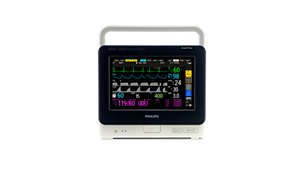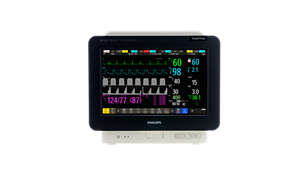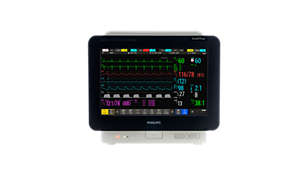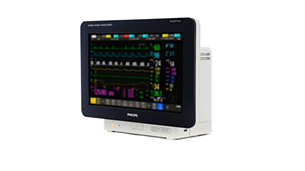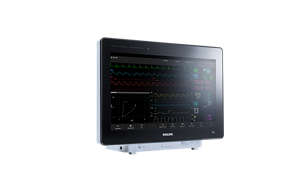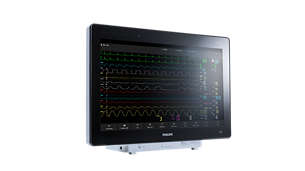Philips Sounds





Transforming the sound of care
Working in partnership with world-renowned audio engineers and musicians, Philips has re-imagined monitor sounds, designing the first hospital sound environment around the caregiver and their patients. Taking a creative approach to the growing problem of alarm fatigue and hospital noise levels1, Philips aims to transform the healing environment for clinicians and patients across the hospital.

IntelliVue MX850 bedside patient monitor
The Philips IntelliVue MX850 bedside patient monitor directly addresses the evolving security needs of the healthcare IT landscape, with a range of capabilities that support your cybersecurity strategies. In addition, this outstanding, premium monitor offers advanced functionality, flexible configuration options and an extensive range of measurements. It is well suited to the demands of high-acuity care environments.
Features

A peaceful healing environment for patients and caregivers alike
By some estimates, 80%2 of all sound inside areas such as ICUs can be attributed to patient monitors. An average of 350 alarms per-patient per-day3 and of those 85-99% are false positives4, 5. Most companies use a standard set of alarm sounds (IEC-ISO) with little innovation given to all the beeps and chirps coming out of the monitor. Philips saw this as an opportunity to innovative and set out to address the critical problem of alarm fatigue by transforming the sounds themselves.

Subtle changes. A dramatic effect.
Philips worked with a team of leading sound designers and musicians to introduce a soundscape that softens and rounds out the harsh edges of traditional patient monitoring sounds. This was rigorously tested and refined, unveiling a soundscape that’s more pleasing to the ear while helping the clinician better decipher the endless sounds they’re exposed to.

Toning down alarm fatigue
Clinicians need solutions to manage the stressful and noisy healing environment. Too many alarms can also lead to a potentially dangerous situation where an alarm is ignored, accidentally silenced or misinterpreted. Establishing an effective alarm management strategy is key but is typically an exercise in what to silence and when. Could your care environment benefit from a more refined approach to alarms? Please contact us below.
Philips Sounds technology is available on*
-
IntelliVue MX400
The IntelliVue MX400 provides powerful monitoring in a highly compact, highly transportable unit. Supplying comprehensive patient information at a glance, it can make a real difference when multiple patients and priorities need attention.
866060 -
IntelliVue MX450
The IntelliVue MX450 patient monitor combines powerful monitoring with flexible portability in one compact unit. Supplying comprehensive patient information at a glance, it can make a real difference when multiple patients and priorities need attention.
866062 -
IntelliVue MX500
The IntelliVue MX500 combines powerful monitoring with flexible portability in one compact unit. Supplying comprehensive patient information at a glance, it can make a real difference when multiple patients and priorities need attention.
866064 -
IntelliVue MX550
The IntelliVue MX550 pairs powerful bedside monitoring with the reassurance of a battery backup. Supplying comprehensive patient information at a glance, it can make a real difference when multiple patients and priorities need attention.
866066 -
IntelliVue MX750
The IntelliVue MX750 is the critical care workhorse of the IntelliVue family, covering a wide range of intensive care and anesthesia use cases and applications. Featuring direct access to hospital applications via HTML5, Citrix, and optional integrated PC, the monitor is also designed to support cybersecurity features such as node authentication, network data encryption, print report encryption and device data encryption, and includes a built-in RFID/NFC card reader.
866471 -
IntelliVue MX850
The IntelliVue MX850, with its multi-display and multi-user capabilities, is built for the highest-acuity patients and the most demanding interventions, such as cardiothoracic or transplant surgery. Featuring direct access to the hospital applications via HTML5, Citrix, and optional integrated PC, the monitor is also designed to support cybersecurity features such as node authentication, network data encryption, print report encryption and device data encryption, and includes a built-in RFID/NFC card reader.
866470
“…less fatiguing, less annoying for staff and patient”
“perfect pitch, tone and frequency”
Quotations from Philips research,
with physicians, nurses, patients, families and other hospital staff.
Footnotes
*Product features may not be available in all geographies. Please check with your Philips representative for complete portfolio availability. [2] Cho, O. M., Kim, H., Lee, Y. W., & Cho, I. (2016). Clinical Alarms in Intensive Care Units: Perceived Obstacles of Alarm Management and Alarm Fatigue in Nurses. Healthcare Informatics Research, 22(1), 46–53. [3] Jones K. (2014). Alarm fatigue a top patient safety hazard. CMAJ : Canadian Medical Association journal = journal de l’Association medicale canadienne, 186(3), 178.https://doi.org/10.1503/cmaj.109-4696. [4] O’Carroll TM. Survey of alarms in an intensive therapy unit. Anaesthesia. 1986 Jul;41(7):742-4. doi: 10.1111/j.1365-2044.1986.tb12844.x. PMID: 3463228. [5] Graham KC, Cvach M. Monitor alarm fatigue: standardizing use of physiological monitors and decreasing nuisance alarms. Am J Crit Care. 2010 Jan;19(1):28-34; quiz 35. doi: 10.4037/ajcc2010651. PMID: 20045845.
[1] Joseph, B. E., Mehazabeen, H., & U, M. (2020). Noise pollution in hospitals - A study of public perception. Noise & health, 22(104), 28–33. https://doi.org/10.4103/nah.NAH_13_20.
